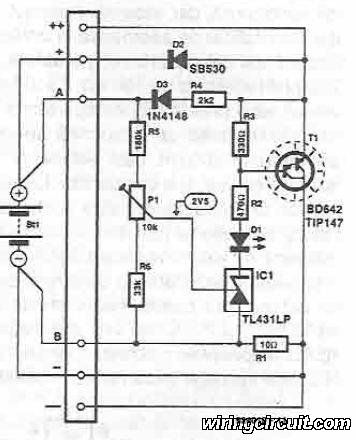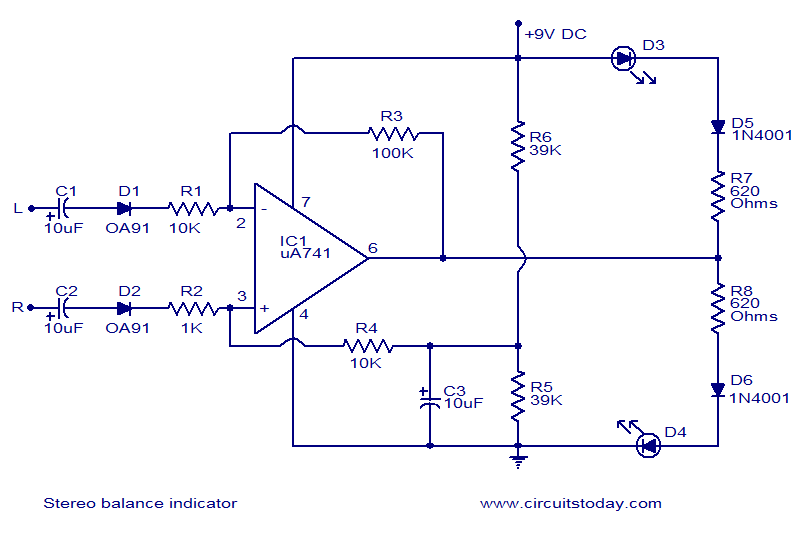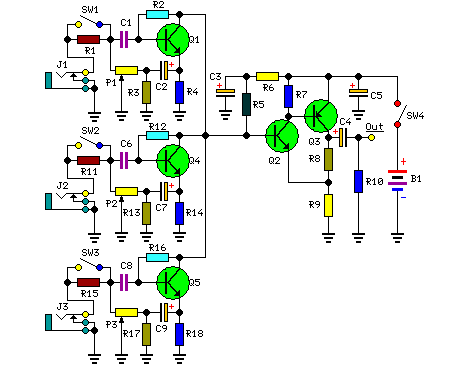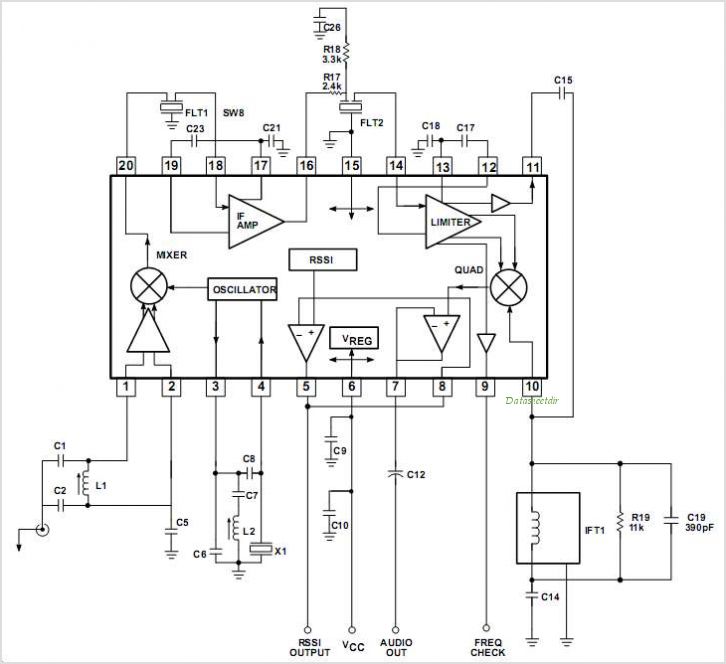
Stereo Mixer With Pan Controls
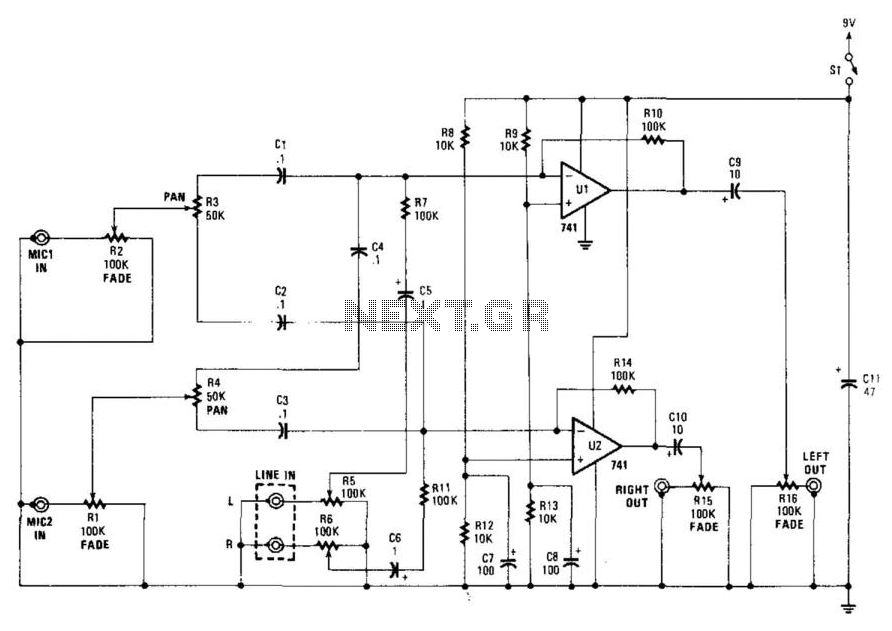
This stereo mixer features two mono mixers and a modification to the microphone inputs. When a microphone is in use, its output is directed to the microphone input of the circuit. The signal is then processed through resistors R1 and R2, which function as faders. The signal is subsequently divided into two distinct paths by resistors R3 and R4, allowing for adjustment of the microphone inputs within the stereo panorama. The stereo line inputs serve this purpose. By combining the microphone inputs with the output from other sources, such as a tape deck or turntable, all signals are routed to the inverting input of an operational amplifier (op-amp). The output is then sent to the master-fade potentiometers, which regulate the output level.
This stereo mixer circuit is designed to provide flexibility in audio mixing with an emphasis on microphone integration. The dual mono mixer configuration allows for independent control of two audio sources, enhancing the overall mixing capabilities. The modification to the microphone inputs ensures that the signals from microphones can be effectively processed alongside other audio sources.
The use of resistors R1 and R2 as faders is crucial for achieving a smooth transition in volume levels. By adjusting these resistors, the user can finely tune the input levels of the microphones before they are mixed with other audio signals. The subsequent division of the signal paths through resistors R3 and R4 facilitates the spatial positioning of the microphone inputs within the stereo field. This is particularly beneficial for live sound applications, where the placement of sound sources in the stereo panorama can significantly impact the listening experience.
The integration of stereo line inputs allows for seamless mixing of additional audio sources. This feature is essential for applications where multiple audio devices, such as tape decks or turntables, are utilized. The routing of all signals to the inverting input of an op-amp ensures that the mixer maintains a high degree of signal integrity while providing the necessary amplification for further processing.
Finally, the output stage incorporates master-fade potentiometers, which enable the user to control the overall output level of the mixed signals. This feature is vital for achieving the desired loudness and balance in the final audio output, making it suitable for a variety of audio applications, from recording studios to live performances. Overall, this stereo mixer design emphasizes versatility, allowing for a comprehensive approach to audio mixing and sound engineering. This stereo mixer has two mono mixers and a modification to the microphone inputs. When a microphone is in u se, the microphone"s output is fed to the microphone input of the circuit. The signal is then run into R1 and R2 (which are used as faders). The signal is then split into two different paths by resistors R3 and R4, with which it is possible to change the place of the microphone inputs within the stereo panorama. The stereo line inputs are for that purpose. Joining the microphone inputs with the output of some other source (such as a tape deck, turntable, etc.), all the signals are fed to the inverting input of an op amp.
The output reaches the master-fade potentiometers, which control output level.
This stereo mixer circuit is designed to provide flexibility in audio mixing with an emphasis on microphone integration. The dual mono mixer configuration allows for independent control of two audio sources, enhancing the overall mixing capabilities. The modification to the microphone inputs ensures that the signals from microphones can be effectively processed alongside other audio sources.
The use of resistors R1 and R2 as faders is crucial for achieving a smooth transition in volume levels. By adjusting these resistors, the user can finely tune the input levels of the microphones before they are mixed with other audio signals. The subsequent division of the signal paths through resistors R3 and R4 facilitates the spatial positioning of the microphone inputs within the stereo field. This is particularly beneficial for live sound applications, where the placement of sound sources in the stereo panorama can significantly impact the listening experience.
The integration of stereo line inputs allows for seamless mixing of additional audio sources. This feature is essential for applications where multiple audio devices, such as tape decks or turntables, are utilized. The routing of all signals to the inverting input of an op-amp ensures that the mixer maintains a high degree of signal integrity while providing the necessary amplification for further processing.
Finally, the output stage incorporates master-fade potentiometers, which enable the user to control the overall output level of the mixed signals. This feature is vital for achieving the desired loudness and balance in the final audio output, making it suitable for a variety of audio applications, from recording studios to live performances. Overall, this stereo mixer design emphasizes versatility, allowing for a comprehensive approach to audio mixing and sound engineering. This stereo mixer has two mono mixers and a modification to the microphone inputs. When a microphone is in u se, the microphone"s output is fed to the microphone input of the circuit. The signal is then run into R1 and R2 (which are used as faders). The signal is then split into two different paths by resistors R3 and R4, with which it is possible to change the place of the microphone inputs within the stereo panorama. The stereo line inputs are for that purpose. Joining the microphone inputs with the output of some other source (such as a tape deck, turntable, etc.), all the signals are fed to the inverting input of an op amp.
The output reaches the master-fade potentiometers, which control output level.
